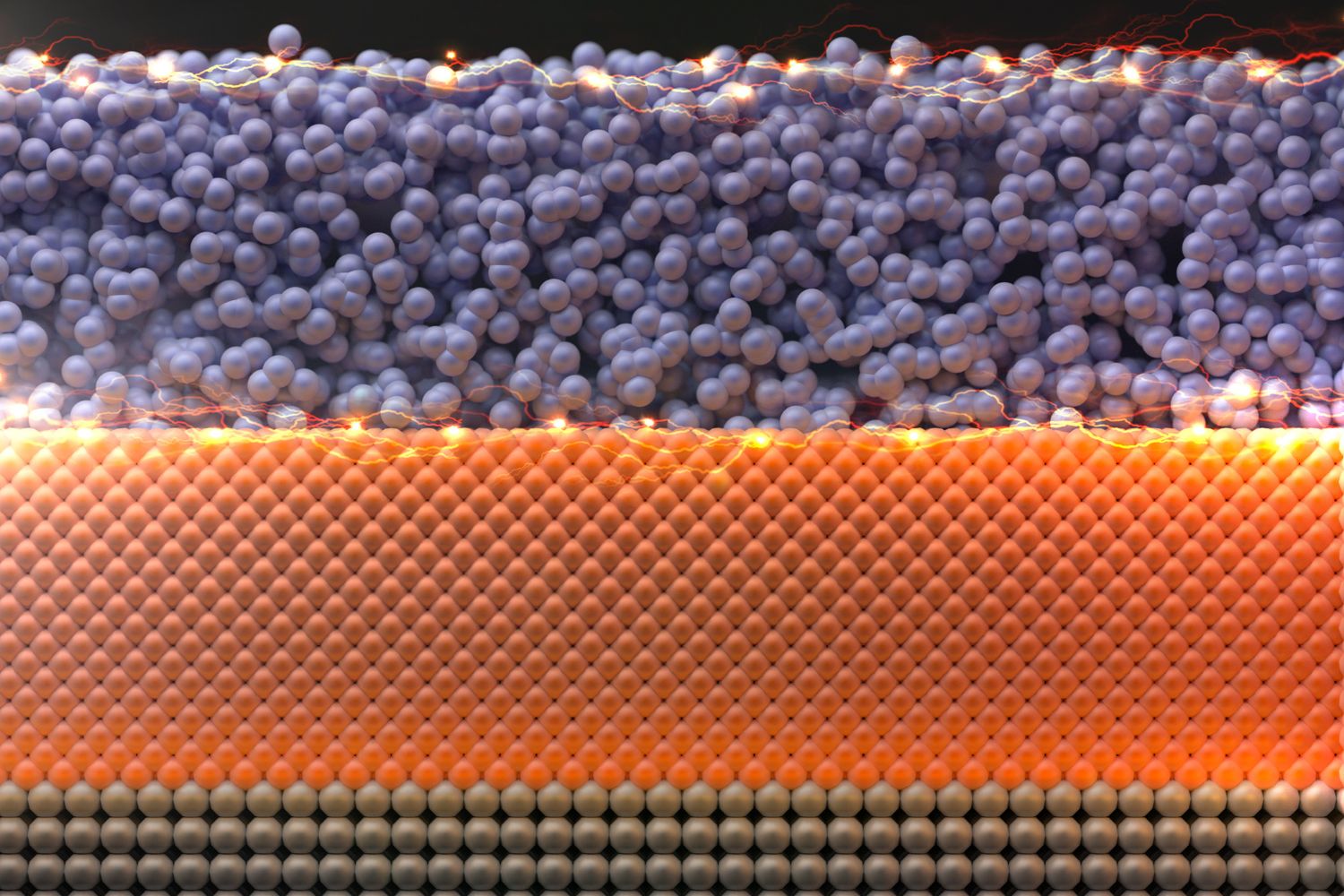As computer chips continue to get smaller and more complex, the ultrathin metallic wires that carry electrical signals within these chips have become a weak link. Standard metal wires get worse at conducting electricity as they get thinner, ultimately limiting the size, efficiency, and performance of nanoscale electronics.
In a paper published Jan. 3 in Science, Stanford researchers show that niobium phosphide can conduct electricity better than copper in films that are only a few atoms thick. Moreover, these films can be created and deposited at sufficiently low temperatures to be compatible with modern computer chip fabrication. Their work could help make future electronics more powerful and more energy efficient.
"We are breaking a fundamental bottleneck of traditional materials like copper," said Asir Intisar Khan, who received his doctorate from Stanford and is now a visiting postdoctoral scholar and first author on the paper. "Our niobium phosphide conductors show that it's possible to send faster, more efficient signals through ultrathin wires. This could improve the energy efficiency of future chips, and even small gains add up when many chips are used, such as in the massive data centers that store and process information today."
A new class of conductors
Niobium phosphide is what researchers call a topological semimetal, which means that the whole material can conduct electricity, but its outer surfaces are more conductive than the middle. As a film of niobium phosphide gets thinner, the middle region shrinks but its surfaces stay the same, allowing the surfaces to contribute a greater share to the flow of electricity and the material as a whole to become a better conductor. Traditional metals like copper, on the other hand, become worse at conducting electricity once they are thinner than about 50 nanometers.
The researchers found that niobium phosphide became a better conductor than copper at film thicknesses below 5 nanometers, even when operating at room temperature. At this size, copper wires struggle to keep up with rapid-fire electrical signals and lose a lot more energy to heat.
"Really high-density electronics need very thin metal connections, and if those metals are not conducting well, they are losing a lot of power and energy," said Eric Pop, the Pease-Ye Professor in the School of Engineering, a professor of electrical engineering, and senior author on the paper. "Better materials could help us spend less energy in small wires and more energy actually doing computation."
","additional":{"file_info":{"file_name":"NbpConductors_Schematic_1500_1.jpg","size_readable":"255.5 KB","size_bytes":261584,"width":1500,"height":1000,"modified_readable":"Jan 6, 2025 2:19 PM","modified_unix":1736201957},"varieties":[{"id":"163609:v1","type":"image_variety","type_name":"Image Variety","version":"","name":"100w","short_name":"100w","status":{"id":16,"code":"live","name":"Live"},"created":{"date":"1969-12-31T16:00:00-08:00","user_id":null},"updated":{"date":"1969-12-31T16:00:00-08:00","user_id":null},"published":{"date":null,"user_id":null},"status_changed":{"date":"1969-12-31T16:00:00-08:00","user_id":null},"urls":["https://news.stanford.edu/__data/assets/image/0025/163609/varieties/100w.jpg"],"url":"https://news.stanford.edu/__data/assets/image/0025/163609/varieties/100w.jpg","attributes":{"variety_type":"resize","filename":"100w.jpg","name":"100w","title":"Schematic","caption":"Credit: Il-Kwon Oh/Asir Khan","variety_size":4676,"variety_height":100,"variety_width":100,"alt":"A few atoms thick film of non-crystalline NbP conducts better through the surface to make the material, as a whole, a better conductor.","dimension_min":0,"dimension":100,"height":0,"width":0,"constrain":"centre_weighted_square"},"metadata":null,"contents":"","additional":{}},{"id":"163609:v2","type":"image_variety","type_name":"Image Variety","version":"","name":"150w","short_name":"150w","status":{"id":16,"code":"live","name":"Live"},"created":{"date":"1969-12-31T16:00:00-08:00","user_id":null},"updated":{"date":"1969-12-31T16:00:00-08:00","user_id":null},"published":{"date":null,"user_id":null},"status_changed":{"date":"1969-12-31T16:00:00-08:00","user_id":null},"urls":["https://news.stanford.edu/__data/assets/image/0025/163609/varieties/150w.jpg"],"url":"https://news.stanford.edu/__data/assets/image/0025/163609/varieties/150w.jpg","attributes":{"variety_type":"resize","filename":"150w.jpg","name":"150w","title":"Schematic","caption":"Credit: Il-Kwon Oh/Asir Khan","variety_size":8737,"variety_height":150,"variety_width":150,"alt":"A few atoms thick film of non-crystalline NbP conducts better through the surface to make the material, as a whole, a better conductor.","dimension_min":0,"dimension":150,"height":0,"width":0,"constrain":"centre_weighted_square"},"metadata":null,"contents":"","additional":{}},{"id":"163609:v3","type":"image_variety","type_name":"Image Variety","version":"","name":"200w","short_name":"200w","status":{"id":16,"code":"live","name":"Live"},"created":{"date":"1969-12-31T16:00:00-08:00","user_id":null},"updated":{"date":"1969-12-31T16:00:00-08:00","user_id":null},"published":{"date":null,"user_id":null},"status_changed":{"date":"1969-12-31T16:00:00-08:00","user_id":null},"urls":["https://news.stanford.edu/__data/assets/image/0025/163609/varieties/200w.jpg"],"url":"https://news.stanford.edu/__data/assets/image/0025/163609/varieties/200w.jpg","attributes":{"variety_type":"resize","filename":"200w.jpg","name":"200w","title":"Schematic","caption":"Credit: Il-Kwon Oh/Asir Khan","variety_size":10400,"variety_height":133,"variety_width":200,"alt":"A few atoms thick film of non-crystalline NbP conducts better through the surface to make the material, as a whole, a better conductor.","dimension_min":0,"dimension":0,"height":200,"width":200,"constrain":"width"},"metadata":null,"contents":"","additional":{}},{"id":"163609:v4","type":"image_variety","type_name":"Image Variety","version":"","name":"300w","short_name":"300w","status":{"id":16,"code":"live","name":"Live"},"created":{"date":"1969-12-31T16:00:00-08:00","user_id":null},"updated":{"date":"1969-12-31T16:00:00-08:00","user_id":null},"published":{"date":null,"user_id":null},"status_changed":{"date":"1969-12-31T16:00:00-08:00","user_id":null},"urls":["https://news.stanford.edu/__data/assets/image/0025/163609/varieties/300w.jpg"],"url":"https://news.stanford.edu/__data/assets/image/0025/163609/varieties/300w.jpg","attributes":{"variety_type":"resize","filename":"300w.jpg","name":"300w","title":"Schematic","caption":"Credit: Il-Kwon Oh/Asir Khan","variety_size":10400,"variety_height":133,"variety_width":200,"alt":"A few atoms thick film of non-crystalline NbP conducts better through the surface to make the material, as a whole, a better conductor.","dimension_min":0,"dimension":0,"height":300,"width":200,"constrain":"width"},"metadata":null,"contents":"","additional":{}},{"id":"163609:v5","type":"image_variety","type_name":"Image Variety","version":"","name":"345w","short_name":"345w","status":{"id":16,"code":"live","name":"Live"},"created":{"date":"1969-12-31T16:00:00-08:00","user_id":null},"updated":{"date":"1969-12-31T16:00:00-08:00","user_id":null},"published":{"date":null,"user_id":null},"status_changed":{"date":"1969-12-31T16:00:00-08:00","user_id":null},"urls":["https://news.stanford.edu/__data/assets/image/0025/163609/varieties/345w.jpg"],"url":"https://news.stanford.edu/__data/assets/image/0025/163609/varieties/345w.jpg","attributes":{"variety_type":"resize","filename":"345w.jpg","name":"345w","title":"Schematic","caption":"Credit: Il-Kwon Oh/Asir Khan","variety_size":26202,"variety_height":230,"variety_width":345,"alt":"A few atoms thick film of non-crystalline NbP conducts better through the surface to make the material, as a whole, a better conductor.","dimension_min":0,"dimension":0,"height":555,"width":345,"constrain":"width"},"metadata":null,"contents":"","additional":{}},{"id":"163609:v6","type":"image_variety","type_name":"Image Variety","version":"","name":"375w","short_name":"375w","status":{"id":16,"code":"live","name":"Live"},"created":{"date":"1969-12-31T16:00:00-08:00","user_id":null},"updated":{"date":"1969-12-31T16:00:00-08:00","user_id":null},"published":{"date":null,"user_id":null},"status_changed":{"date":"1969-12-31T16:00:00-08:00","user_id":null},"urls":["https://news.stanford.edu/__data/assets/image/0025/163609/varieties/375w.jpg"],"url":"https://news.stanford.edu/__data/assets/image/0025/163609/varieties/375w.jpg","attributes":{"variety_type":"resize","filename":"375w.jpg","name":"375w","title":"Schematic","caption":"Credit: Il-Kwon Oh/Asir Khan","variety_size":30405,"variety_height":250,"variety_width":375,"alt":"A few atoms thick film of non-crystalline NbP conducts better through the surface to make the material, as a whole, a better conductor.","dimension_min":0,"dimension":0,"height":200,"width":375,"constrain":"width"},"metadata":null,"contents":"","additional":{}},{"id":"163609:v7","type":"image_variety","type_name":"Image Variety","version":"","name":"400w","short_name":"400w","status":{"id":16,"code":"live","name":"Live"},"created":{"date":"1969-12-31T16:00:00-08:00","user_id":null},"updated":{"date":"1969-12-31T16:00:00-08:00","user_id":null},"published":{"date":null,"user_id":null},"status_changed":{"date":"1969-12-31T16:00:00-08:00","user_id":null},"urls":["https://news.stanford.edu/__data/assets/image/0025/163609/varieties/400w.jpg"],"url":"https://news.stanford.edu/__data/assets/image/0025/163609/varieties/400w.jpg","attributes":{"variety_type":"resize","filename":"400w.jpg","name":"400w","title":"Schematic","caption":"Credit: Il-Kwon Oh/Asir Khan","variety_size":33504,"variety_height":267,"variety_width":400,"alt":"A few atoms thick film of non-crystalline NbP conducts better through the surface to make the material, as a whole, a better conductor.","dimension_min":0,"dimension":0,"height":100,"width":400,"constrain":"width"},"metadata":null,"contents":"","additional":{}},{"id":"163609:v8","type":"image_variety","type_name":"Image Variety","version":"","name":"555w","short_name":"555w","status":{"id":16,"code":"live","name":"Live"},"created":{"date":"1969-12-31T16:00:00-08:00","user_id":null},"updated":{"date":"1969-12-31T16:00:00-08:00","user_id":null},"published":{"date":null,"user_id":null},"status_changed":{"date":"1969-12-31T16:00:00-08:00","user_id":null},"urls":["https://news.stanford.edu/__data/assets/image/0025/163609/varieties/555w.jpg"],"url":"https://news.stanford.edu/__data/assets/image/0025/163609/varieties/555w.jpg","attributes":{"variety_type":"resize","filename":"555w.jpg","name":"555w","title":"Schematic","caption":"Credit: Il-Kwon Oh/Asir Khan","variety_size":57888,"variety_height":370,"variety_width":555,"alt":"A few atoms thick film of non-crystalline NbP conducts better through the surface to make the material, as a whole, a better conductor.","dimension_min":0,"dimension":0,"height":0,"width":555,"constrain":"width"},"metadata":null,"contents":"","additional":{}},{"id":"163609:v9","type":"image_variety","type_name":"Image Variety","version":"","name":"600w","short_name":"600w","status":{"id":16,"code":"live","name":"Live"},"created":{"date":"1969-12-31T16:00:00-08:00","user_id":null},"updated":{"date":"1969-12-31T16:00:00-08:00","user_id":null},"published":{"date":null,"user_id":null},"status_changed":{"date":"1969-12-31T16:00:00-08:00","user_id":null},"urls":["https://news.stanford.edu/__data/assets/image/0025/163609/varieties/600w.jpg"],"url":"https://news.stanford.edu/__data/assets/image/0025/163609/varieties/600w.jpg","attributes":{"variety_type":"resize","filename":"600w.jpg","name":"600w","title":"Schematic","caption":"Credit: Il-Kwon Oh/Asir Khan","variety_size":63439,"variety_height":400,"variety_width":600,"alt":"A few atoms thick film of non-crystalline NbP conducts better through the surface to make the material, as a whole, a better conductor.","dimension_min":0,"dimension":0,"height":0,"width":600,"constrain":"width"},"metadata":null,"contents":"","additional":{}},{"id":"163609:v10","type":"image_variety","type_name":"Image Variety","version":"","name":"690w","short_name":"690w","status":{"id":16,"code":"live","name":"Live"},"created":{"date":"1969-12-31T16:00:00-08:00","user_id":null},"updated":{"date":"1969-12-31T16:00:00-08:00","user_id":null},"published":{"date":null,"user_id":null},"status_changed":{"date":"1969-12-31T16:00:00-08:00","user_id":null},"urls":["https://news.stanford.edu/__data/assets/image/0025/163609/varieties/690w.jpg"],"url":"https://news.stanford.edu/__data/assets/image/0025/163609/varieties/690w.jpg","attributes":{"variety_type":"resize","filename":"690w.jpg","name":"690w","title":"Schematic","caption":"Credit: Il-Kwon Oh/Asir Khan","variety_size":80298,"variety_height":460,"variety_width":690,"alt":"A few atoms thick film of non-crystalline NbP conducts better through the surface to make the material, as a whole, a better conductor.","dimension_min":0,"dimension":0,"height":0,"width":690,"constrain":"width"},"metadata":null,"contents":"","additional":{}},{"id":"163609:v11","type":"image_variety","type_name":"Image Variety","version":"","name":"705w","short_name":"705w","status":{"id":16,"code":"live","name":"Live"},"created":{"date":"1969-12-31T16:00:00-08:00","user_id":null},"updated":{"date":"1969-12-31T16:00:00-08:00","user_id":null},"published":{"date":null,"user_id":null},"status_changed":{"date":"1969-12-31T16:00:00-08:00","user_id":null},"urls":["https://news.stanford.edu/__data/assets/image/0025/163609/varieties/705w.jpg"],"url":"https://news.stanford.edu/__data/assets/image/0025/163609/varieties/705w.jpg","attributes":{"variety_type":"resize","filename":"705w.jpg","name":"705w","title":"Schematic","caption":"Credit: Il-Kwon Oh/Asir Khan","variety_size":82509,"variety_height":470,"variety_width":705,"alt":"A few atoms thick film of non-crystalline NbP conducts better through the surface to make the material, as a whole, a better conductor.","dimension_min":0,"dimension":0,"height":0,"width":705,"constrain":"width"},"metadata":null,"contents":"","additional":{}},{"id":"163609:v12","type":"image_variety","type_name":"Image Variety","version":"","name":"750w","short_name":"750w","status":{"id":16,"code":"live","name":"Live"},"created":{"date":"1969-12-31T16:00:00-08:00","user_id":null},"updated":{"date":"1969-12-31T16:00:00-08:00","user_id":null},"published":{"date":null,"user_id":null},"status_changed":{"date":"1969-12-31T16:00:00-08:00","user_id":null},"urls":["https://news.stanford.edu/__data/assets/image/0025/163609/varieties/750w.jpg"],"url":"https://news.stanford.edu/__data/assets/image/0025/163609/varieties/750w.jpg","attributes":{"variety_type":"resize","filename":"750w.jpg","name":"750w","title":"Schematic","caption":"Credit: Il-Kwon Oh/Asir Khan","variety_size":92718,"variety_height":500,"variety_width":750,"alt":"A few atoms thick film of non-crystalline NbP conducts better through the surface to make the material, as a whole, a better conductor.","dimension_min":0,"dimension":0,"height":0,"width":750,"constrain":"width"},"metadata":null,"contents":"","additional":{}},{"id":"163609:v13","type":"image_variety","type_name":"Image Variety","version":"","name":"795w","short_name":"795w","status":{"id":16,"code":"live","name":"Live"},"created":{"date":"1969-12-31T16:00:00-08:00","user_id":null},"updated":{"date":"1969-12-31T16:00:00-08:00","user_id":null},"published":{"date":null,"user_id":null},"status_changed":{"date":"1969-12-31T16:00:00-08:00","user_id":null},"urls":["https://news.stanford.edu/__data/assets/image/0025/163609/varieties/795w.jpg"],"url":"https://news.stanford.edu/__data/assets/image/0025/163609/varieties/795w.jpg","attributes":{"variety_type":"resize","filename":"795w.jpg","name":"795w","title":"Schematic","caption":"Credit: Il-Kwon Oh/Asir Khan","variety_size":99712,"variety_height":530,"variety_width":795,"alt":"A few atoms thick film of non-crystalline NbP conducts better through the surface to make the material, as a whole, a better conductor.","dimension_min":0,"dimension":0,"height":0,"width":795,"constrain":"width"},"metadata":null,"contents":"","additional":{}},{"id":"163609:v14","type":"image_variety","type_name":"Image Variety","version":"","name":"960w","short_name":"960w","status":{"id":16,"code":"live","name":"Live"},"created":{"date":"1969-12-31T16:00:00-08:00","user_id":null},"updated":{"date":"1969-12-31T16:00:00-08:00","user_id":null},"published":{"date":null,"user_id":null},"status_changed":{"date":"1969-12-31T16:00:00-08:00","user_id":null},"urls":["https://news.stanford.edu/__data/assets/image/0025/163609/varieties/960w.jpg"],"url":"https://news.stanford.edu/__data/assets/image/0025/163609/varieties/960w.jpg","attributes":{"variety_type":"resize","filename":"960w.jpg","name":"960w","title":"Schematic","caption":"Credit: Il-Kwon Oh/Asir Khan","variety_size":129332,"variety_height":640,"variety_width":960,"alt":"A few atoms thick film of non-crystalline NbP conducts better through the surface to make the material, as a whole, a better conductor.","dimension_min":0,"dimension":0,"height":0,"width":960,"constrain":"width"},"metadata":null,"contents":"","additional":{}},{"id":"163609:v15","type":"image_variety","type_name":"Image Variety","version":"","name":"1024w","short_name":"1024w","status":{"id":16,"code":"live","name":"Live"},"created":{"date":"1969-12-31T16:00:00-08:00","user_id":null},"updated":{"date":"1969-12-31T16:00:00-08:00","user_id":null},"published":{"date":null,"user_id":null},"status_changed":{"date":"1969-12-31T16:00:00-08:00","user_id":null},"urls":["https://news.stanford.edu/__data/assets/image/0025/163609/varieties/1024w.jpg"],"url":"https://news.stanford.edu/__data/assets/image/0025/163609/varieties/1024w.jpg","attributes":{"variety_type":"resize","filename":"1024w.jpg","name":"1024w","title":"Schematic","caption":"Credit: Il-Kwon Oh/Asir Khan","variety_size":143422,"variety_height":683,"variety_width":1024,"alt":"A few atoms thick film of non-crystalline NbP conducts better through the surface to make the material, as a whole, a better conductor.","dimension_min":0,"dimension":0,"height":0,"width":1024,"constrain":"width"},"metadata":null,"contents":"","additional":{}},{"id":"163609:v16","type":"image_variety","type_name":"Image Variety","version":"","name":"1110w","short_name":"1110w","status":{"id":16,"code":"live","name":"Live"},"created":{"date":"1969-12-31T16:00:00-08:00","user_id":null},"updated":{"date":"1969-12-31T16:00:00-08:00","user_id":null},"published":{"date":null,"user_id":null},"status_changed":{"date":"1969-12-31T16:00:00-08:00","user_id":null},"urls":["https://news.stanford.edu/__data/assets/image/0025/163609/varieties/1110w.jpg"],"url":"https://news.stanford.edu/__data/assets/image/0025/163609/varieties/1110w.jpg","attributes":{"variety_type":"resize","filename":"1110w.jpg","name":"1110w","title":"Schematic","caption":"Credit: Il-Kwon Oh/Asir Khan","variety_size":161329,"variety_height":740,"variety_width":1110,"alt":"A few atoms thick film of non-crystalline NbP conducts better through the surface to make the material, as a whole, a better conductor.","dimension_min":0,"dimension":0,"height":0,"width":1110,"constrain":"width"},"metadata":null,"contents":"","additional":{}},{"id":"163609:v17","type":"image_variety","type_name":"Image Variety","version":"","name":"1410w","short_name":"1410w","status":{"id":16,"code":"live","name":"Live"},"created":{"date":"1969-12-31T16:00:00-08:00","user_id":null},"updated":{"date":"1969-12-31T16:00:00-08:00","user_id":null},"published":{"date":null,"user_id":null},"status_changed":{"date":"1969-12-31T16:00:00-08:00","user_id":null},"urls":["https://news.stanford.edu/__data/assets/image/0025/163609/varieties/1410w.jpg"],"url":"https://news.stanford.edu/__data/assets/image/0025/163609/varieties/1410w.jpg","attributes":{"variety_type":"resize","filename":"1410w.jpg","name":"1410w","title":"Schematic","caption":"Credit: Il-Kwon Oh/Asir Khan","variety_size":227002,"variety_height":940,"variety_width":1410,"alt":"A few atoms thick film of non-crystalline NbP conducts better through the surface to make the material, as a whole, a better conductor.","dimension_min":0,"dimension":0,"height":0,"width":1410,"constrain":"width"},"metadata":null,"contents":"","additional":{}},{"id":"163609:v18","type":"image_variety","type_name":"Image Variety","version":"","name":"1500w","short_name":"1500w","status":{"id":16,"code":"live","name":"Live"},"created":{"date":"1969-12-31T16:00:00-08:00","user_id":null},"updated":{"date":"1969-12-31T16:00:00-08:00","user_id":null},"published":{"date":null,"user_id":null},"status_changed":{"date":"1969-12-31T16:00:00-08:00","user_id":null},"urls":["https://news.stanford.edu/__data/assets/image/0025/163609/varieties/1500w.jpg"],"url":"https://news.stanford.edu/__data/assets/image/0025/163609/varieties/1500w.jpg","attributes":{"variety_type":"resize","filename":"1500w.jpg","name":"1500w","title":"Schematic","caption":"Credit: Il-Kwon Oh/Asir Khan","variety_size":257393,"variety_height":1000,"variety_width":1500,"alt":"A few atoms thick film of non-crystalline NbP conducts better through the surface to make the material, as a whole, a better conductor.","dimension_min":0,"dimension":0,"height":0,"width":1500,"constrain":"width"},"metadata":null,"contents":"","additional":{}}],"exif":{"image":{"ImageHeight":1000,"ImageWidth":1500,"Orientation":0,"ResolutionUnit":0,"XResolution":96,"YCbCrPositioning":0,"YResolution":96},"exif":{"ColorSpace":0,"ExifImageHeight":1000,"ExifImageWidth":1500}}}}}">

A film a few atoms thick of non-crystalline niobium phosphide conducts better through the surface to make the material, as a whole, a better conductor. | Il-Kwon Oh / Asir Khan






